From the Twelve
Fruits With Potential Value-Added and Culinary Uses
by Ken Love, Richard Bowen, and Kent Fleming
Tree
Tomato (Tamarillo)
Scientific name: Cyphomandra
betacea
(Cav.) Sendt.
Family: Solanaceae
Origin:
Peruvian Andes and Bolivia
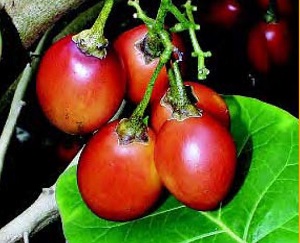
Introduction
The tree tomato or tamarillo is a shallow rooted tree that can reach a
height of 20 feet.
The
wood is brittle and the trees short lived, usually lasting from 12 to
15 years. The almost heart shaped leaves can reach a foot or more in
length and a width of up to 5 inches. The fragrant flowers, up to a
1/2-inch diameter can be pink, light blue or white and are usually
borne near the tips of the branches. Trees produce fruit that is red,
yellow, orange or purple, the long stemmed fruit, 3 inches long by 1.5
inches wide is generally ovoid with somewhat pointed ends. The seeds
are thin, flat and hard. The tree is related to poha, tomatillo and
lulo. Commonly referred to as tree tomato, the name tamarillo was
devised in 1967 in New Zealand for marketing purposes.
Poha
(Physalis peruviana)
was observed growing in Hawaii by naturalist
Andrew Bloxum in 1825. Sharing a geographic point of origin with tree
tomato, there is some speculation that it might have been introduced to
Hawaii around the same time, both fruit having been referred to as
“lost crops of the Incas”, who, cultivated the
trees prior
to Columbus finding the New World.
Varieties
The
Tree tomato does not grow true from seed and there is a wide variety of
fruit color and size of tree tomatoes found in Hawaii. In New Zealand,
‘Red Beau’, (1991), and ‘Kaitaia
Yellow’,
(1981), are two popular cultivars. Selections found in California and
Florida includes ‘Rothamer’, ‘Oratia
Red’,
‘Inca Gold’ and ‘Ecuadorian
Orange’. Breeding
programs in Brazil have also produced local selections.
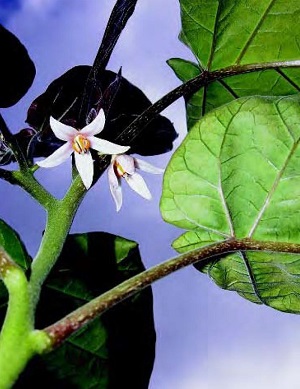
Tree tomato flowers
Environment
The
tree tomato is a subtropical that is usually found from the 1000 to
10,000-foot elevations in its native environment. In Hawaii it is found
from 200 to 4000-foot elevation. Trees at lower elevations tend to
produce more but smaller fruit. The plants prefer a lightly compacted
soil with good drainage. Roots will not tolerate standing water, which
may kill the tree in a matter of days. Protection from wind is
essential for these shallow rooted trees. Brittle branches are also
susceptible to winds, especially when laden with fruit. Trees will
produce fruit after 18 months but it is considered advisable to remove
the first year’s fruit in order to strengthen the root
system.
Trees in New Zealand’s large commercial plantings are short
lived, lasting only 4 to 6 years. In Hawaii, trees will produce up to
15 years with proper care and nutrition. On average, a cluster of 20
flowers will produce only 4 or 5 fruit. Flowers will abort if not
pollinated. It takes approximately 25 weeks from fruit set to maturity.
Culture
New
Zealand’s commercial harvest of tamarillo averaged 1500
metric
tons in 2004 with 100 tons being exported and 100 being processed. The
remainder was sold as fresh fruit.
Seedlings are field planted
when they are 2 to 5 inches in height, spaced from 6 to 10 feet apart.
In windy areas, they are often planted closer together. The flowers are
often removed the first year and root growth encouraged. Bone meal is
commonly used when planting in New Zealand. Trees are cut back severely
each year to a height of 3 to 4 feet to encourage branching. In Hawaii,
a quarterly application of 1/4 pound of organic 6-6-6 is recommended.
In the 5th year of growth additional applications 2 to 3 pounds of
mixed phosphate, nitrate of soda and sulphate of potash is recommended.
Annual pruning should be practiced, removing branches that have
previously fruited. Judicious pruning can also help to extend the
fruiting season and facilitate harvesting. Irrigation is only needed in
periods of drought. Good mulching will alleviate tree stress under
drought conditions. Trees prefer organically rich light soil.
Pests and
Diseases
The
tree tomato is susceptible to a number of problems, which can be
controlled with proper care. Fruit flies will sting the fruit. The
tough skin offers protection but makes the fruit unattractive for
marketing as fresh. The Hawaii Areawide Fruit Fly Pest Management
Program (HAW-FLYPM) is very effective in preventing damaged fruit. The
most common problem, powdery mildew (Oidium sp.), can be
addressed with
applications of commercial insecticide soaps and neem oil sprays.
Root-knot nematodes (Meloidogyne
sp.), Root rot; crown rot
(Phytophthora
sp.) and wilt from Pseudomonas
solanacearum also affect
the plant. Good cultural practices should help to stave off these
problems.
Propagation
Tree tomatoes can be propagated by cuttings of 1 to 2 year old growth
and by seeds.
Tissue
culture is practiced in New Zealand. Seeds tend to produce taller
trees; better suited to protected areas while trees from cuttings tend
to be shorter and bushier making them better for windy areas.
Harvesting
and Yield
Fruit
should be picked with the stem on or cut with a small piece of stem
left intact. The tough skin lets pickers place the fruit into bags or
directly into boxes. The fruit ripens over a 6 to 8 week period in
Hawaii, generally from September through May depending on location and
elevation.
Cultivated fields in New Zealand can produce more
than 6 tons of fruit per acre. In Hawaii, a single tree can produce
more than 60 pounds of fruit annually.
Postharvest
Quality
Tree
tomatoes can be stored for up to 9 weeks if kept between 37.4 to 40
°F with 90 to 95% relative humidity. The fruit suffers from
chilling injury if kept below 37.4 °F. Decay occurs if the
fruit is
stored above 40 °F. Peeled fruit can be processed and frozen.
It
can also be placed into jars with sugar syrup to preserve it for future
use when following the USDA guidelines for preserving.
Cost of
Production
The
project tamarillo tree produced an annual marketable yield of 54.0
pounds. The average market price was $5.00 per pound, and therefore the
tree generated a gross revenue of $270.00 for the year. Growing costs
(fertilization, irrigation, pruning and all weed and pest control)
amounted to $30.57, and harvesting costs (picking, packing and delivery
to market) totaled $57.70. (All labor to grow and harvest the
tamarillos was assumed to be paid at an hourly wage rate of $16.00,
including withholding, FICA and benefits.) Thus, the total annual
operating costs, sometimes referred to as “variable
costs,”
were $88.27. The gross margin (gross revenue minus all operating costs)
was $181.73.
The tamarillo gross margin is the amount of money
available to pay all the ownership costs associated with the tamarillo
enterprise. Ownership costs, sometimes referred to as “fixed
costs,” include the value of land used (rent or rent
equivalent
or mortgage and property taxes), the value of the capital investment
(such as the tree establishment cost and buildings and vehicles), the
value of the management, and the value of any unpaid labor. (All paid
labor is already included in the gross margin.) Ownership costs, unlike
operating costs, will vary substantially from farm to farm and will
depend largely on how the farming operation is financed and on
economies of scale. Each grower will have to calculate his total farm
ownership costs and then allocate an appropriate portion of these costs
to each enterprise on the farm. Now the profitability of the tamarillo
enterprise can be determined by subtracting the tamarillo
enterprise’s share of the total ownership costs from the
gross
margin for tamarillos.
The cost and return data are what was
obtained from the 12 Trees Project site and other locations. Yields and
costs were based on optimal growing conditions for one or more trees at
various locations; different results will be obtained under different
growing conditions. The prices used were actually obtained in 2005 and
2006. There is no guarantee that these prices will continue, especially
if production increases significantly. These costs and returns are
simply a starting point for growers to make their own estimates.
Packaging,
Pricing and Marketing
The fruit is packed in egg type cartons after being graded to size in
New Zealand.
Small, medium and large fruits are sold direct to wholesalers, stores
and processors.
In Hawaii, imported fruit is sold individually, retailed for as much as
$10.99 per pound.
Locally
grown fruit sold in the Kona district to groceries is packed 3 or 4
fruit per plastic container and wholesales for $5.00 per pound. Big
Island hotel and restaurant chefs purchase 10 to 20 pounds of fruit at
a time packed in boxes.
Food Uses and
Nutrition
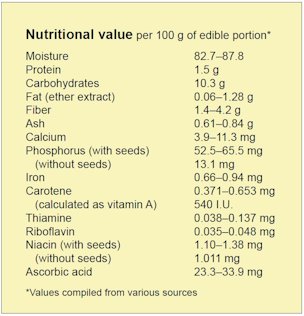

Tree
tomatoes are highly versatile for culinary use. They can be used as a
substitute for tomatoes, cut fresh in salads, served sweetened in
desserts or added to spicy sauces. Chutney made with the fruit is
highly valued in New Zealand and often found served in place of tomato
ketchup. West Hawaii chefs have developed a number of recipes, curries
and chutneys using the fruit.
Recipes
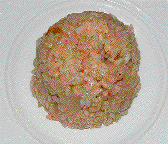
Tree Tomato
Rice
By Teri Wisdom
Hawaii Community College – West Hawaii Culinary Arts Program
Serving Size: 6 to 8
2 cups sweet rice, washed and drained
2 cups white rice, washed and drained
8 cups water
3 tbl. veggie oil
3 cloves of garlic, crushed
2 lbs. chicken, cut into bite size pieces
1 medium onion, diced
3 chopped tree tomatoes
1 Cup chicken broth
2 medium green bell peppers, sliced into thin strips
1 tbl. annatto seeds soaked in ¼ cup water for 30 min.
tbl. raisins
1 tsp. salt
1/2tsp. pepper
3 hard cooked eggs
Procedure:
1) Cook Rice
2) Heat oil in large pot, sauté garlic till light brown. Add
chicken and brown.
3) Add onions and tree tomatoes , cook until onions are soft.
4) Add the chicken broth, cover, and simmer for 8-10 min. or when the
chicken is tender.
5) Remove seeds from water and stir in veggies for the orange color. Be
sure to not add seeds.
6) Add the cooked rice, raisins, salt and pepper and mix well.
7) Cook 10 minutes more, stirring occasionally to prevent burning.
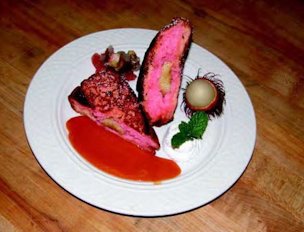
Banana-stuffed guava French toast with tree tomato sauce 
Tree Tomato
Sauce
By Chef Paul Heerlein
6 oz ginger
4 cups white wine
36 oz passion orange juice
1 orange Zest
3 quarts pineapple juice
2 tsp brown cloves
1 tbs allspice
22 lbs tree tomato
Procedure:
1. In sauce pan, add white wine and ginger and reduce by half.
2. Add all remaining items except tree tomato and reduce half way
3. Add tree tomato and reduce to desired consistency
About
the Twelve Fruits
With Potential Value-Added and Culinary Uses Project
Back to
Tamarillo Page
|
© 2007, University of Hawai'i
|




